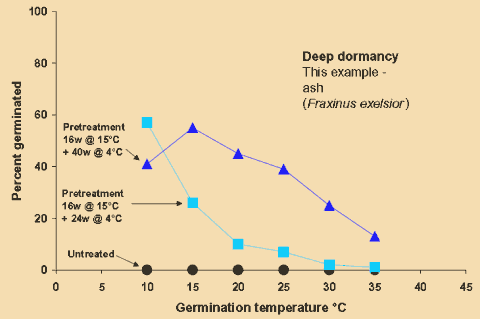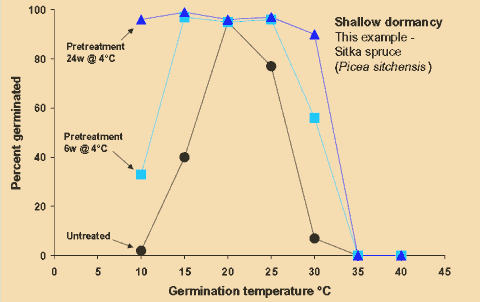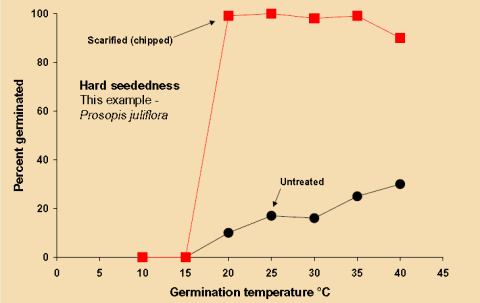A dormant seed is one which is alive, but does not germinate when provided with ample water, good aeration and a suitable temperature (i.e. the normal requirements for plant growth).
Virtually all tree seeds are dormant:
- Some are described as deeply dormant – they are completely unable to germinate until pretreated.
- Some are described as shallowly dormant – they only germinate slowly and over a narrow range of conditions until pretreated.
- Some are described as hard-seeded – they do not germinate until their impermeable seed coat has been pretreated.
The three figures below demonstrate the characteristics of two sorts of temperate tree seed dormancy and also tropical tree seeds with so called hard-seededness.
Deep dormancy

Some seeds exhibit ‘deep dormancy’ – the embryo tissues absorb water, begin to metabolise and respire, but remain outwardly inactive at all temperatures.
These seeds appear to have a complete metabolic block (or blocks) to cell elongation, growth, development and differentiation under all conditions.
See graph to observe:
- Untreated ‘deeply dormant’ seeds do not germinate at any temperature.
- There is an absolute requirement for relatively lengthy pretreatment to bring about any germination at all.
- Germination capacity tends to be better at lower temperatures.
- Longer pretreatment durations (within species limits) tend to be better.
Examples: Most temperate broadleaved species plus Juniperus spp. and Taxus spp.
Shallow dormancy

Some seeds exhibit ‘shallow dormancy’ – the embryo tissues absorb water, begin to metabolise and respire, but remain outwardly inactive at most temperatures.
Shallowly dormant seeds also have a complete metabolic block (or blocks) to cell elongation, growth, development and differentiation – but only under some conditions.
See graph to observe:
- Untreated ‘shallowly dormant’ seeds germinate at some temperatures but not all.
- Pretreatment increases germination capacity at most temperatures.
- Longer pretreatment durations (within species limits) tend to be better.
Examples: Most temperate conifer species plus Alnus spp. and Betula spp.
Hard-seededness

Some seeds exhibit ‘hard-seededness’ – often the result of an impermeable seed coat acting as a barrier to water uptake so that the embryo tissues cannot hydrate.
See graph to observe:
- A few untreated seeds may have permeable coats and germinate at most temperatures.
- Pretreatment (e.g ‘scarification1‘) stimulates virtually all live seeds to germinate at most temperatures.
Examples: Most temperate and tropical legume tree species.
1 Scarification – any ‘pretreatment’ that removes, abrades, splits, burns or softens the hard seed-coat – without significantly damaging the embryo within; e.g., chipping, filing, boiling / hot water. These are the ONLY tree seeds which do not need to be moist to respond to pretreatment.
